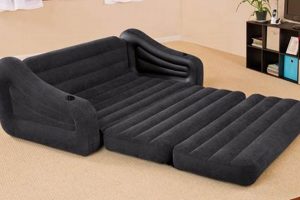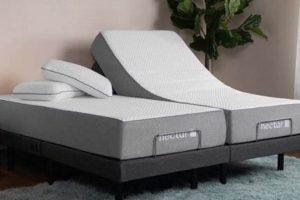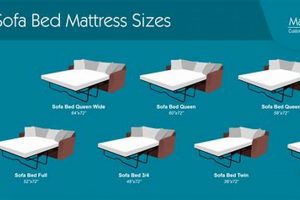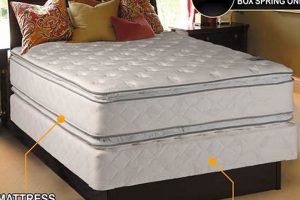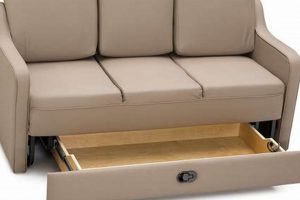The examination of a mattress for signs of bed bug infestation involves a meticulous inspection of seams, crevices, and surfaces. This process aims to identify the presence of live bed bugs, their shed skins (exuviae), fecal stains (small, dark spots), or eggs, indicating an active or past infestation. For example, one would systematically scrutinize the mattress’s edges, paying close attention to areas where fabric is folded or stitched together.
Detecting bed bugs early is crucial for preventing a full-blown infestation and minimizing the associated health and financial burdens. Early detection allows for prompt treatment, reducing the likelihood of widespread dispersal within a dwelling and mitigating potential allergic reactions or psychological distress linked to bed bug bites. Historically, vigilance regarding bed bugs was more common before the widespread use of modern pesticides; current heightened awareness is largely due to the resurgence of these pests in recent decades.
This article will delve into the specific methods and tools necessary to effectively perform a mattress inspection for bed bugs. It will outline a step-by-step guide, covering visual examination techniques, the use of magnification aids, and strategies for interpreting observed evidence to determine the presence and extent of a potential bed bug problem. The information provided will empower individuals to proactively assess their sleeping environment and take appropriate remedial actions.
Tips on Mattress Inspection for Bed Bugs
The following are recommended practices to ensure a thorough and effective mattress inspection for bed bugs.
Tip 1: Prepare the Inspection Area: Remove all bedding, including sheets, blankets, and mattress protectors. Adequate lighting is essential; utilize a flashlight or room light for optimal visibility.
Tip 2: Focus on Seams and Crevices: Bed bugs frequently congregate in the mattress’s seams, welts, and tufts. Use a credit card or similar thin object to gently pry open these areas for closer inspection.
Tip 3: Examine the Underside: Thoroughly inspect the mattress’s underside and any attached labels. These areas provide secluded hiding places for bed bugs and their eggs.
Tip 4: Look for Stains and Shed Skins: Dark fecal stains, resembling small ink dots, and shed exoskeletons are indicators of bed bug activity. Pay particular attention to these signs, especially around seams and edges.
Tip 5: Employ a Magnifying Glass: A magnifying glass allows for a more detailed examination of suspect areas, aiding in the identification of bed bugs and their eggs, which can be difficult to see with the naked eye.
Tip 6: Inspect the Box Spring: Bed bugs often infest the box spring as well. Lift the mattress and examine the box spring’s fabric covering and wooden frame, paying close attention to staples and joints.
Tip 7: Document Findings: If evidence of bed bugs is found, photograph the infested areas. This documentation can be beneficial for pest control professionals.
Consistent and meticulous mattress inspections, adhering to these tips, offer the greatest chance of early bed bug detection, mitigating potential infestations and associated issues.
Following these inspection guidelines is paramount before implementing treatment strategies or contacting pest control services.
1. Visual Inspection
Visual inspection serves as the initial and fundamental step in the process of checking a mattress for bed bugs. The method entails a thorough, systematic scan of the entire mattress surface, including the top, sides, and bottom, to identify any visible signs of infestation. The effectiveness of subsequent, more targeted inspection methods is largely dependent on the diligence and detail applied during this primary visual assessment. For example, the presence of dark, rust-colored stains on the mattress surface, often indicative of crushed bed bugs or their excrement, would be initially identified during this visual overview.
The absence of immediate visual evidence does not negate the possibility of bed bugs, but it guides the subsequent steps in the inspection. If no obvious signs are apparent, a more focused examination of seams, crevices, and other potential hiding places becomes necessary. Conversely, the discovery of visual indicators necessitates a more intensive investigation of the surrounding area and potential treatment options. A failure to conduct a comprehensive visual inspection can lead to a delayed detection, allowing the infestation to worsen and spread to other areas. For instance, a cursory glance might miss a small cluster of bed bug eggs nestled within the mattress stitching, leading to a future outbreak.
In summary, visual inspection provides the groundwork for effective bed bug detection on mattresses. It directs further investigation and influences subsequent actions. Its success hinges on careful observation and a systematic approach, highlighting its essential role in the broader process. The identification of even subtle visual cues, such as small stains or shed skins, can prompt timely intervention and prevent extensive infestations.
2. Seam Examination
Seam examination constitutes a critical component in the process of checking a mattress for bed bugs. The intricate folds and stitch lines of mattress seams provide ideal harborage for these pests due to the darkness, protection, and proximity to a host. A focused inspection of these areas is thus essential for accurate bed bug detection.
- Habitat Preference
Bed bugs exhibit a preference for tight, concealed spaces. Mattress seams, with their multiple layers and tight stitching, mimic these conditions, offering refuge from disturbance and predation. The textured surface of the seam also aids in gripping and navigating the mattress.
- Evidence Accumulation
Seams are often locations where evidence of bed bug activity accumulates. Exuviae, or shed skins from nymphal molting, tend to collect within the seams recesses. Fecal stains, produced by digested blood, are also frequently deposited in these areas, creating dark, clustered spots.
- Egg Deposition Sites
Female bed bugs often deposit their eggs within mattress seams. The adhesive nature of the eggs allows them to securely attach to the fabric fibers, making seams a prime location for egg clusters. These eggs, small and pearly white, can be difficult to detect without careful scrutiny.
- Tool Utilization
Effective seam examination often necessitates the use of tools to separate and illuminate the fabric folds. A thin, flat object, such as a credit card or spatula, can be used to gently pry open the seam, allowing for a more thorough visual inspection. A
flashlight or magnifying glass can further aid in identifying small or concealed evidence.
In conclusion, a meticulous seam examination is indispensable when checking a mattress for bed bugs. The characteristic habitat preferences of bed bugs, the accumulation of evidentiary signs, and the use of specialized tools all contribute to the importance of this specific inspection technique. Disregarding the examination of seams significantly diminishes the likelihood of detecting an early infestation and can lead to protracted and more challenging pest control efforts.
3. Underside Review
The underside review represents a vital, often overlooked, element of mattress inspection protocols intended to detect bed bugs. While the top surface and seams typically receive immediate attention, the mattress underside, including its fabric lining and the wooden frame of an attached box spring, can harbor significant bed bug populations. Neglecting this area significantly increases the risk of a missed diagnosis, leading to prolonged infestation.
Several factors contribute to the importance of this step. The underside of a mattress offers a darker, less disturbed environment, attractive to bed bugs seeking refuge. Furthermore, this area is often in direct contact with the bed frame or floor, providing easier access for the pests. For example, bed bugs may initially establish themselves within the crevices of a wooden bed frame and subsequently migrate to the mattress underside before infesting the more exposed top surface. Another practical consideration is the potential for dust accumulation and debris, which can obscure visual signs such as fecal spotting or shed skins, thereby requiring careful and methodical examination of the underside. A comprehensive approach to mattress inspection necessitates dismantling the bed frame to allow for thorough examination of the box spring’s underside, as well.
The effective implementation of an underside review, coupled with other inspection techniques, greatly increases the likelihood of early bed bug detection. This proactive approach not only facilitates timely intervention but also minimizes the potential for widespread infestation and the associated costs of remediation. Omitting this critical step represents a significant deficiency in the overall inspection process, undermining its effectiveness and potentially leading to persistent bed bug problems. A complete and consistent application of all steps ensures robust protection against these unwelcome pests.
4. Fecal Stain Search
The fecal stain search is an essential procedure within the process of determining the presence of bed bugs on a mattress. Bed bug fecal stains are small, dark spots typically black or dark brown composed of digested blood excreted by the insects. Their presence on a mattress serves as a definitive indicator of bed bug activity. Without conducting a thorough fecal stain search, an accurate determination of infestation levels is significantly hindered.
The appearance and distribution of fecal stains offer valuable clues. For example, clusters of stains along mattress seams, particularly near the head or foot, strongly suggest a bed bug harborage in close proximity. The absence of stains does not entirely negate the possibility of infestation, as low-level populations may not produce visible staining. However, the presence of fecal stains corroborates other signs, such as the detection of live bugs or shed skins. In practical terms, a mattress with numerous dark spots requires immediate and comprehensive treatment, whereas a stain-free mattress warrants continued monitoring and preventative measures. The absence of a proper fecal stain search introduces a significant blind spot in the overall mattress inspection, increasing the risk of misdiagnosis and delayed intervention.
In summary, the fecal stain search is a critical component in the comprehensive assessment. Diligence in identifying these stains aids in swift identification and remediation. The effectiveness of this technique hinges on careful and deliberate examination, emphasizing the interconnectedness of each element within a holistic bed bug detection strategy. Understanding the significance of fecal stains and integrating their search into standard mattress inspection protocols enhances the ability to proactively manage bed bug infestations.
5. Shed Skin Hunt
The process of searching for shed skins (exuviae) is an integral step in assessing a mattress for bed bug infestation. Bed bugs, like all insects, undergo a molting process as they mature, shedding their exoskeletons multiple times during their life cycle. These shed skins, therefore, provide tangible evidence of bed bug presence and activity on a mattress.
- Identification of Molting Stages
Bed bugs molt five times before reaching adulthood. Each shed skin corresponds to a specific nymphal stage. Identifying these shed skins confirms the presence of developing bed bugs and aids in estimating the infestation’s duration. Recognizing the different sizes of exuviae can indicate the presence of various age classes of bed bugs on the mattress.
- Location of Shed Skins
Bed bug shed skins are most commonly found in areas where bed bugs congregate, such as mattress seams, crevices, and folds. They may also be found on the underside of the mattress or on nearby furniture. A thorough search should focus on these areas, utilizing a flashlight and magnifying glass for enhanced visibility.
- Distinguishing Shed Skins from Other Debris
Bed bug shed skins are typically translucent or light brown in color and retain the general shape of the bed bug. They can be differentiated from dust particles or other debris by their distinct segmented body and leg structures. Careful examination is crucial to avoid misidentification.
- Implications for Infestation Assessment
The presence of numerous shed skins suggests a well-established and potentially long-term infestation. A few shed skins may indicate a more recent or localized presence. The distribution and concentration of shed skins can help pinpoint the primary areas of bed bug activity on the mattress, guiding targeted treatment strategies.
The shed skin hunt, therefore, forms a crucial part of the comprehensive process. Detecting shed skins can supplement findings from visual inspections and fecal stain searches, increasing the certainty of diagnosis and informing appropriate remedial action. Consistent and diligent searches enhance early detection and prevent escalation of the infestation.
6. Egg Identification
Egg identification is a critical component within the broader process of checking a mattress for bed bugs, serving as direct evidence of ongoing reproduction and potential future infestation. The presence of bed bug eggs indicates that an active population exists and is likely to persist unless intervention occurs. Without effectively i
dentifying and addressing the presence of eggs, efforts to control bed bug populations on a mattress may prove incomplete or temporary, leading to a resurgence of the infestation. For example, a mattress might appear clean of live bed bugs after a superficial inspection, yet a hidden cluster of eggs can hatch weeks later, re-establishing the colony.
Bed bug eggs are small, approximately 1 mm in length, and are typically pearly white or translucent, making them difficult to detect without careful scrutiny. They are often laid in clusters within mattress seams, crevices, or along the underside of the fabric. A magnifying glass and a focused light source are essential tools for successful egg identification. The eggs are also coated in a sticky substance, which adheres them to the surface on which they are deposited, making them difficult to remove without physical disruption. A visual inspection that specifically targets potential egg-laying sites and employs magnification enhances the likelihood of detecting and addressing these crucial indicators of bed bug activity. Consider the scenario where a homeowner diligently inspects their mattress but overlooks the eggs attached to the box spring; this oversight will eventually lead to a renewed infestation, highlighting the importance of complete egg identification.
In summary, egg identification is fundamental to any comprehensive mattress inspection aimed at detecting bed bugs. The presence of eggs confirms active reproduction and the potential for continued infestation. Diligent search and appropriate identification practices are essential. These steps are critical to prevent future outbreaks. Only a holistic approach that incorporates egg detection can ensure the effectiveness of any bed bug control strategy applied to a mattress. The challenge lies in the diminutive size and camouflaged nature of bed bug eggs, necessitating a methodical and detail-oriented approach.
Frequently Asked Questions
This section addresses common inquiries regarding the detection of bed bugs on mattresses. The information presented aims to clarify procedures and provide insights into effective inspection techniques.
Question 1: What are the first steps one should take when beginning a mattress inspection for bed bugs?
The initial steps involve removing all bedding materials, including sheets, blankets, and mattress protectors. Adequate lighting, preferably supplemented with a flashlight, is essential for optimal visibility during the inspection.
Question 2: Where on a mattress are bed bugs most likely to be found?
Bed bugs are frequently found in mattress seams, crevices, tufts, and along the edges. The underside of the mattress and the box spring should also be inspected thoroughly, as these areas offer secluded hiding places.
Question 3: What are the key signs to look for during a mattress inspection for bed bugs?
Key indicators include live bed bugs, shed skins (exuviae), fecal stains (small, dark spots), and eggs. Fecal stains are typically found in clusters, while shed skins resemble translucent versions of the bed bugs themselves.
Question 4: Is it necessary to disassemble the bed frame to effectively inspect for bed bugs?
While not always mandatory, disassembling the bed frame allows for a more comprehensive inspection, particularly of the box spring and the frame itself. Bed bugs may harbor in the joints and crevices of the bed frame.
Question 5: Can bed bugs be present on a mattress even if no bites are apparent on the occupants?
Yes, it is possible for bed bugs to infest a mattress without causing immediate or noticeable bites. Some individuals do not react to bed bug bites, or the reactions may be delayed, making detection challenging.
Question 6: What tools are recommended for a thorough mattress inspection for bed bugs?
Essential tools include a flashlight, a magnifying glass, and a thin, flat object such as a credit card or spatula to pry open seams. A vacuum cleaner is useful for removing any debris or visible bed bugs encountered during the inspection.
The information provided underscores the importance of meticulous and methodical mattress inspections for detecting bed bugs. Early detection is critical for effective management and prevention of widespread infestations.
The next section will address strategies for managing bed bug infestations once they are detected on a mattress, including treatment options and preventative measures.
Conclusion
The comprehensive exploration of the process to check for bed bugs on mattress has revealed the necessity of a multi-faceted approach. Visual inspection, seam examination, underside review, fecal stain search, shed skin hunt, and egg identification each contribute critically to accurate detection. The absence of any single element compromises the overall efficacy of the inspection, potentially leading to undetected infestations and subsequent propagation.
Effective management of potential bed bug infestations begins with consistent and thorough monitoring. Vigilance and proactive inspection practices are paramount in mitigating the risks associated with these persistent pests. Commitment to these procedures can significantly reduce the likelihood of widespread infestation and associated health and economic burdens.


